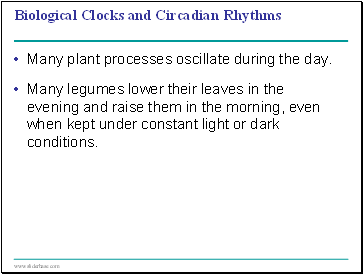Plant Responses to Internal and External SignalsPage
7
7
There are two major classes of light receptors: blue-light photoreceptors and phytochromes.
Blue-light photoreceptors control hypocotyl elongation, stomatal opening, and phototropism.
Phytochromes are pigments that regulate many of a plant’s responses to light throughout its life.
These responses include seed germination and shade avoidance.
Slide 46
Structure of a phytochrome
Two identical subunits
Chromophore
Photoreceptor activity
Kinase activity
Slide 47
Phytochromes exist in two photoreversible states, with conversion of Pr to Pfr triggering many developmental responses.
Red light
Far-red light
Pr
Pfr
Slide 48
Phytochrome: a molecular switching mechanism
Synthesis
Pr
Far-red
light
Slow conversion
in darkness
(some plants)
Enzymatic
destruction
Responses:
seed germination,
control of
flowering, etc.
Pfr
Red light
Slide 49
Biological Clocks and Circadian Rhyths
Many plant processes oscillate during the day.
Many legumes lower their leaves in the evening and raise them in the morning, even when kept under constant light or dark conditions.
Slide 50
Sleep movements of a bean plant
Noon
Midnight
Slide 51
Circadian rhyths are cycles that are about 24 hours long and are governed by an internal “clock.”
Circadian rhyths can be entrained to exactly 24 hours by the day/night cycle.
The clock may depend on synthesis of a protein regulated through feedback control and may be common to all eukaryotes.
Phytochrome conversion marks sunrise and sunset, providing the biological clock with environmental cues.
Slide 52
Photoperiodism and Responses to Seasons
Photoperiod, the relative lengths of night and day, is the environmental stimulus plants use most often to detect the time of year.
Photoperiodism is a physiological response to photoperiod.
Slide 53
Photoperiodism and Control of Flowering
Some processes, including flowering in many species, require a certain photoperiod.
Plants that flower when a light period is shorter than a critical length are called short-day plants.
Plants that flower when a light period is longer than a certain number of hours are called long-day plants.
Contents
- Stimuli and a Stationary Life
- Signal transduction pathways link signal reception to response
- Reception and Transduction
- Response
- Plant hormones help coordinate growth, development, and responses to stimuli
- A Survey of Plant Hormones
- Auxins
- Ethylene
- Systems Biology and Hormone Interactions
- Responses to light are critical for plant success
- Biological Clocks and Circadian Rhyths
- Photoperiodism and Responses to Seasons
- Plants respond to a wide variety of stimuli other than light
- Mechanical Stimuli
- Environmental Stresses
- Plants respond to attacks by herbivores and pathogens
Last added presentations
- Static and Kinetic Friction
- Newton’s law of universal gravitation
- Sound
- Newton’s third law of motion
- Gravitation
- Heat-Energy on the Move
- Magnetic field uses sound waves to ignite sun's ring of fire








